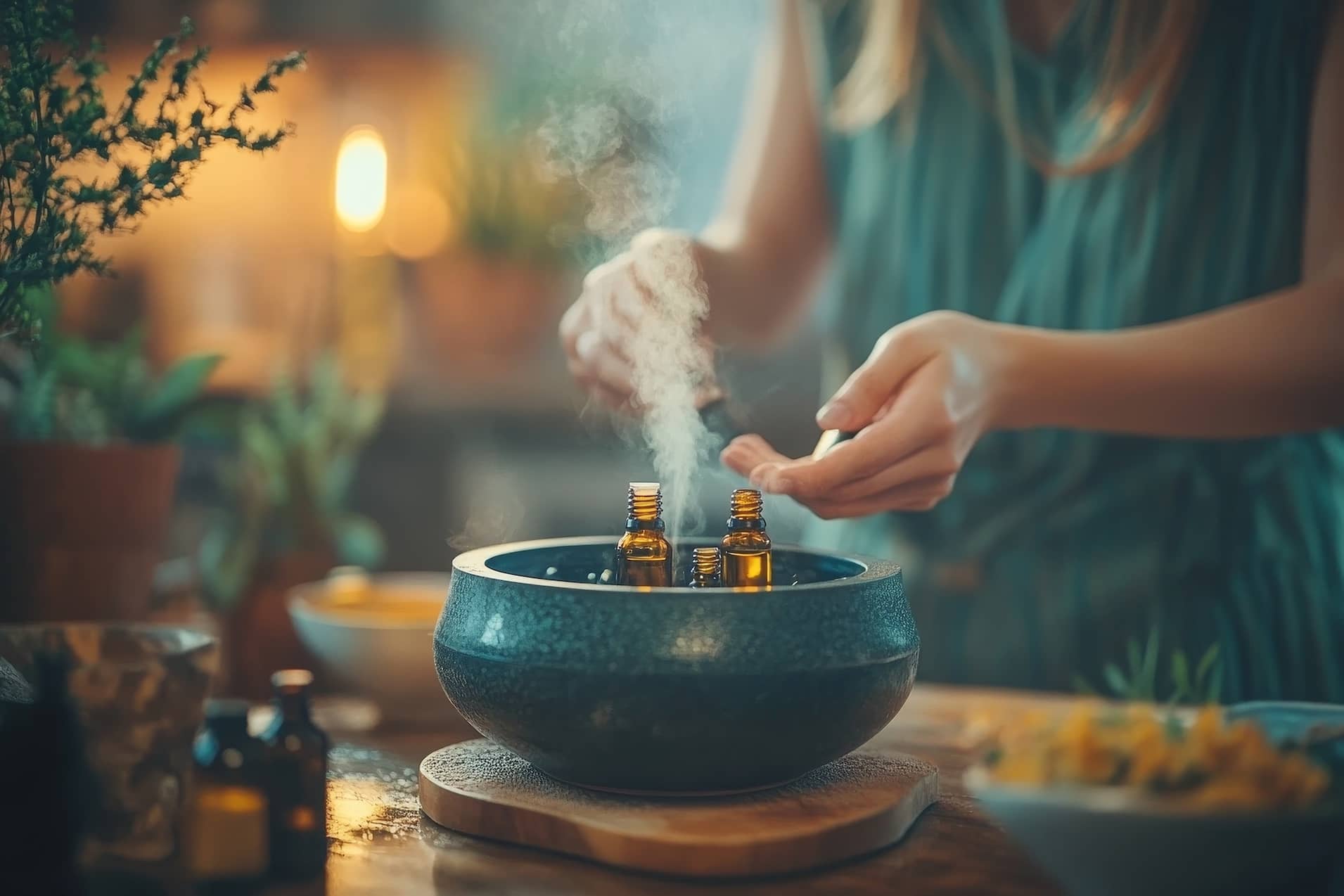Have you ever wondered what essential oil diffusers professionals choose to elevate wellness spaces? Maybe you’d like to pick one for your own home or office.
Or perhaps you entered a friend’s home and thought, “Wow, what’s that amazing fragrance?” You were surprised it wasn’t a candle or a plug‑in—it was a diffuser working its magic.
Estimated reading time: 4 minutes
Heartmanity is proud to partner with outstanding companies that we wholeheartedly recommend so this post may contain affiliate links. This helps keep our content free for you! You can read our full disclosure here.
Table of Contents
- How Essential Oil Diffusers Promote Wellness
- Types of Essential Oil Diffusers Explained
- Purchasing Guide for Diffusers
- The Best Essential Oil Diffusers - Comparison Table
- Why Understanding How to Use Diffusers Is Important
- How to Use Each Diffuser Type
- Choosing the Best Essential Oil Diffuser for You
- Caring for Your Diffuser: Cleaning & Maintenance
- Best Essential Oils to Diffuse
- Safety and Best Practices
- Frequently Asked Questions
What You’ll Learn
- The differences between nebulizing diffusers and ultrasonic devices
- Step-by-step instructions for safe, effective use
- A comparison of Organic Aromas top models
- Pros, cons, and tailored recommendations
- Care tips, health best practices, and answers to common questions
Essential oils are nature’s most concentrated gifts—capturing the fragrance and healing of plants, flowers, roots, and trees in potent aromatic drops. They’ve been used for centuries across many cultures for everything from stress relief to immune support.
Today, with a little know-how, you can harness these benefits in your own home or office using a simple tool: the essential oil diffuser.
How Essential Oil Diffusers Promote Wellness
When I first started using essential oils decades ago, I quickly realized it’s not just about the oil itself—it’s about how you use it. That’s where diffusers come in. Back in the day, diffusers weren't available so I had to add the oils to water in a spray bottle and mist the air regularly. Now, you can have a diffuser doing the work for you!
Think of a diffuser as your personal wellness assistant: it disperses essential oils into the air, transforming any room into a sanctuary of calm, focus, or rejuvenation—whatever you need most in the moment.
Whether you want to boost your energy without caffeine, relax after a stressful day, or replace toxic air fresheners with pure botanical aromas, a diffuser makes it easy.
Best of all, using a diffuser ensures you experience essential oils safely and effectively, maximizing their therapeutic potential while creating an atmosphere that’s uniquely yours.
In this guide, I’ll show you exactly how to choose and use an essential oil diffuser that fits your life—so you can embrace a healthier, more natural way of living, one breath at a time.
Related reading: "Support Optimal Health with Essential Oils."
Types of Essential Oil Diffusers Explained
Nebulizing Diffusers (Waterless)
- Cold-air atomizes pure essential oils—no dilution, no heat, full therapeutic impact.
- Use cold-air jet to atomize 100% pure essential oils into micro particles—no water or heat.
- Ideal for potent, therapeutic distribution
- Models like Radiance or Raindrop deliver powerful potency using the Bernoulli’s Principle.
Ultrasonic Diffusers
These essential oil diffusers mix oils with water to produce a gentle mist; ideal for ambiance and added humidity, but less potent.
Passive Evaporative Diffusers (Reed, Wooden Pod, Fan)
- Rely on air movement to disperse oils gradually (e.g., AromaPods, reed diffusers, car clip-ons).
- Low maintenance and subtle—great for small spaces.
Heat Diffusers (Candle, Bulb-Style)
- Use heat to evaporate oils—effective but may degrade therapeutic properties.
Purchasing Guide for Diffusers: Things That Matter
|
Consideration |
Why It Counts |
|
Intensity & Area |
Nebulizers fill rooms quickly with consistent coverage (~800 sq. ft.); ultrasonics are gentler. |
|
Oil Efficiency |
|
|
Noise |
Nebulizers hum gently; ultrasonics are quieter. |
|
Maintenance |
Nebulizers need monthly alcohol cleaning; ultrasonics need weekly water rinsing. |
|
Therapeutic Effect |
For full wellness benefits, nebulizers are best; for relaxation and humidifying, ultrasonics suffice. |
The Best Essential Oil Diffusers - Comparison Table
Here are the top models currently available from Organic Aromas—my favorites! Also included are a couple of models from Amazon that I've used for years if you're looking for an inexpensive way to go. Explore their features below in the chart comparison.
|
Model |
Type |
Coverage |
Price |
Highlights |
|
Nebulizer |
~800 sq. ft. |
$115 |
Rechargeable, waterless, ideal for travel/desk |
|
|
Nebulizer |
~800 sq. ft. |
$105 |
Elegant dark base, quiet, effective |
|
|
Nebulizer |
~800 sq. ft. |
$98 |
Touch-sensor LEDs, iconic glass + wood design |
|
|
Nebulizer |
~800 sq. ft. |
$125.00 |
Beautiful wood carving that can be customized with your own design, volume switch to control quantity of oil, mood lighting |
|
|
Nebulizer |
~800 sq. ft. |
$175.00 |
Hand-carved wood design with custom-blown glass, mood lighting, low energy consumption, |
|
|
Metal Tree Essential (Amazon) |
Ultrasonic |
~200 sq. ft. |
Under $20 |
Unique design choices, changes colors, extremely quiet, USB-powered, inexpensive |
|
Ultrasonic |
~300 sq. ft. |
Under $35 |
Blends functionality with style, quiet, compact, can act as a humidifier, auto shut-off, 7 color mood lighting, reasonably priced |
Why Understanding “How to Use an Essential Oil Diffuser” Is Important
You’re not just looking to scent a room—you want therapeutic benefits with safe, effective diffusion.
Selecting the right diffuser affects oil potency, coverage, maintenance, and cost. The model you choose not only influences the aroma’s intensity and coverage area, but also impacts ongoing maintenance and your long-term investment. Each diffuser type—be it nebulizing, ultrasonic, evaporative, or heat—offers unique strengths and requires different care routines.
By understanding how each one works, you’ll be able to match a diffuser to your personal needs, space size, and wellness goals.
As you explore your options, it’s important to consider how often you’ll use the diffuser, the therapeutic effects you desire, and your preferred maintenance level. For instance, those seeking highly concentrated aromas for relaxation or immune support may opt for a nebulizing diffuser, while others wanting gentle background fragrance and added humidity might prefer an ultrasonic device.Recognizing the main diffuser categories helps ensure your essential oils are dispersed efficiently and safely, whether at home or in your workspace. With this foundational knowledge, you can confidently select the best essential oil diffuser for your environment and make the most of every drop.
The goal is often to choose and maximize health gains while considering the style for your space so you can confidently decide which diffuser is best for you.
Related reading: "25 Ways to Live Ayurvedic Principles."
How to Use Each Essential Oil Diffuser Type
 Nebulizing Diffusers
Nebulizing Diffusers
- Connect the glass reservoir to the base.
- Add 10–20 drops of pure essential oil (no water).
- Power on using volume/timer controls.
- The unit cycles (e.g., 2 min on / 1 min off for 120 min) and auto-shuts off.
- Clean monthly following the manufacturer’s guide.
Compliments of OrganicAromas.com
Ultrasonic Diffusers
- Fill water reservoir to the line.
- Add 3–6 drops of pure essential oil.
- Set mist mode and optional lights.
- Switch off after 2–4 hours; empty and clean weekly.
Choosing the Best Essential Oil Diffuser for You
Pros, Cons and Recommendations of Different Types of Diffusers
Nebulizing Diffusers
Pros:
- Pure, full-strength oil diffusion
- Rapid coverage (~800 sq. ft.)
- No water or heat—maintains oil integrity
- Made to last
- Often more beautiful
Cons:
- Uses more oil (though more potent)
- Glass parts need careful handling
- Monthly cleaning required
- More expensive
Recommendations:
- Choose the Organic Aroma Radiance for a balance of cost and aesthetics
- Pick Organic Aroma Tranquility if you want portability while maintaining elegance.
- If you want high-quality that you can customize, try Organic Aroma Laser-Engraved for a premium, refined look
Ultrasonic Diffusers
Pros:
- Affordable
- Very quiet
- Adds humidity—good for dry climates
- Gentle ambiance
- Uses less oil each time
Cons:
- Scents and oil dispersal less concentrated
- Higher weekly maintenance
- Plastic can absorb scents
- Not ideal for deep therapeutic use
Recommendation:
- Best if you're seeking mild aroma and ambiance
- If you’re looking for an economical choice, Ultrasonic Diffusers are the way to go.
Caring for Your Diffuser
Nebulizing Diffuser Care
- Monthly: flush glass with isopropyl alcohol, run briefly, rinse and dry
- Store in a cool and dark place to preserve glass and pump.
Ultrasonic Diffuser Care
- Daily: empty water
- Weekly: wipe bowl with a mild alcohol solution (avoid scratching)

Best Essential Oils for Diffusing
There are as many essential oils as there are different kinds of plants, flowers, and trees!
Everyone has their favorites.
However, below are a few of the most versatile and useful oils. These essential oils are my go-tos after using essential oils for many years.
Keep in mind, each person interacts with and responds to essential oils differently. Also, remember that less is more. Some of the oils are very potent and can burn the skin so take it slow and experiment carefully.*
- Lavender – Calming for sleep and stress relief, allergy comfort, soothes bee stings irritation, natural anti-viral, anti-bacteria, great in the bath
- Peppermint - Good for digestion (or indigestion), alertness, focus and energy, fights bacterial infections, helps with congestion
- Lemon (and Citrus Blends) – Uplifting, good for colds and cold sores, diuretic, helps with concentration, mood-lifting freshness
- Lemongrass – Airborne bacteria, diuretic, general tonic, lymphatic support, mental fatigue, muscle strain, purification and cleaning
- Eucalyptus – Air purification, respiratory support, helps with inflammation
- Tea Tree – Anti-bacterial and viral, good to assist with ear infections, earaches, or fungal infections, soothes inflammation, nerve tonic
Experience different oils in your diffuser that set the mood you want or achieve a purpose like purification, scents that energize you or calm you. This is a wellness practice that is fun, with many choices, and completely customizable. Enjoy it!
Deep Dive: "Five Amazing Essential Oils to Get You Motivated."
Safety and Best Practices
- Always use 100% pure essential oils—no synthetics.
- Operate in well-ventilated spaces; avoid continuous use.
- Keep out of reach of children and pets. Animals have a highly sensitive smell and some oils are harmful to them!
- Take care when storing essential oils; some are corrosive to plastic so best to keep in glass.
- Stick to recommended run times and cleaning schedules.
- Avoid thick oils in nebulizers to prevent clogs.
- The better you care for your diffuser, the longer it lasts!

Frequently Asked Questions
How long should I use the diffuser daily?
Nebulizers: 2 min on/1 min off, up to 120 min; ultrasonics: 2–4 hrs. max.
Can I swap oils mid-use?
Yes—but for nebulizers, clean glass thoroughly between oils to avoid blending scents. For ultrasonics, rinse before switching unless you don't mind mixed scents.
How do I clean a nebulizer?
Discard residue, add alcohol, flush tubes with pipette, run for 5 minutes, rinse.
Which diffuser is more economical?
Ultrasonics cost less per drop, but nebulizers deliver stronger effects with slightly higher oil use, but well worth the investment.
Final Thoughts
Now you know how to use an essential oil diffuser and have seen great models you can buy. You can't go wrong with a beautiful accent to your home or office that also has health benefits.
It's a healthy choice to replace harsh chemicals with natural aromatherapy—nature's remedies.
One intentional breath at a time.
Related reading: "8 Surprising Uses for Essential Oils." or "Summer Guide to Essential Oils."
* None of the statements in this blog have been evaluated by the Food and Drug Administration. None of the above recommendations are intended to diagnose, treat, cure, or prevent any condition or disease. Essential oils are naturally produced substances that can assist the body in its own healing process, but we make no claims whatsoever. Use with moderation and discretion.










